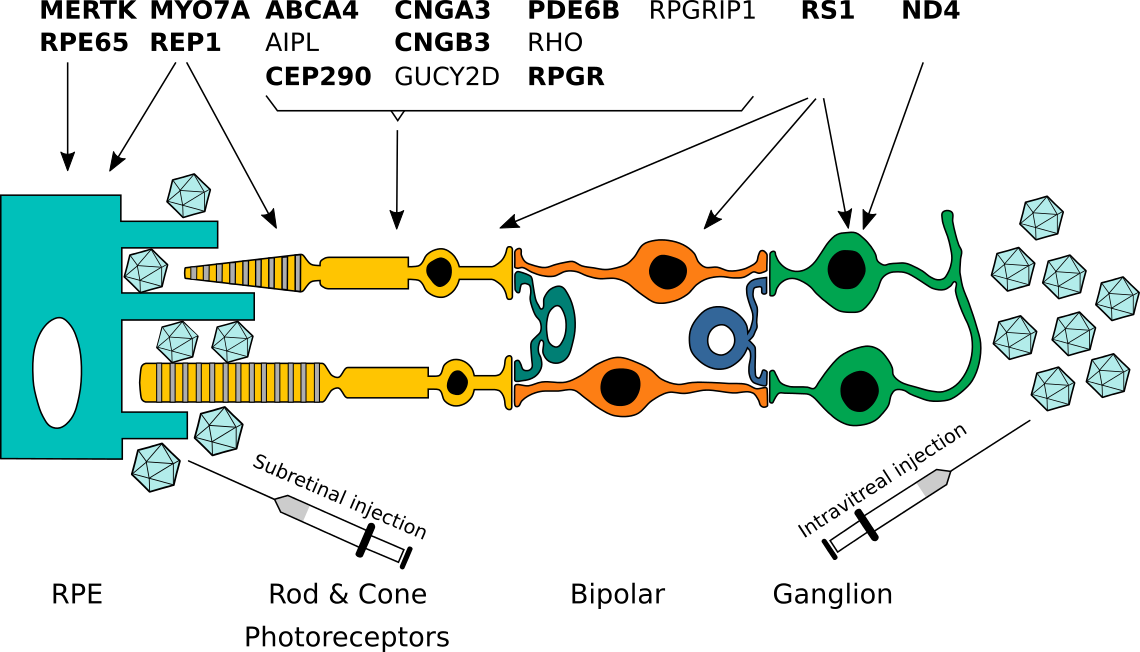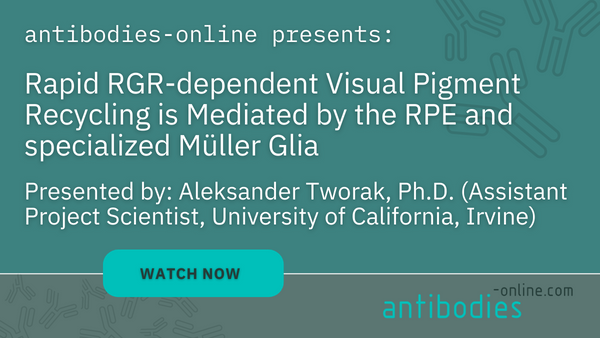Ocular Disease and Gene Therapy
While gene therapy was advancing, it became evident that some tissues are more amenable than others to be targeted by gene delivery. Among them is the eye, which offers several advantages. Retinal gene therapy has advanced considerably in the past three decades. Initial efforts have been devoted to comprehensively explore and optimize the transduction abilities of gene delivery vectors, define the appropriate intraocular administration routes and obtain evidence of efficacy in animal models of inherited retinal diseases (IRDs).

Fig. 1: Schematic representation of the retina and pattern of expression of retinal genes. Genes for which gene therapy approaches are in clinical testing are indicated in bold. RPE: retinal pigment epithelium.
Inherited Diseases of the Eye
Inherited retinal dystrophies (IRDs) include a number of rare disorders caused by genetic defects. These disorders lead to progressive retinal degeneration. IRDs are well suited for gene therapy as the underlying mutations are well understood. In addition delivery of the therapeutic via AAVs or LVs has proven to work. The development of ocular gene therapy over the prior two decades has mainly targeted hereditary retinal diseases because the genetics of many of these diseases have been well characterized and treatment options for these rare diseases are limited.
The most common IRDs are:
Retinitis pigmentosa
Retinitis pigmentosa (RP) refers to a number of inherited retinal diseases. RP leads to peripheral vision loss and night blindness. Retinitis pigmentosa is listed as a rare disease by the NIH.
- (1)
- (1)
- (7)
- (4)
- (1)
- (1)
- (2)
- (1)
Webinar: Rapid RGR-dependent Visual Pigment Recycling is Mediated by the RPE and specialized Müller Glia
Presented by: Aleksander Tworak, Ph.D. (Assistant Project Scientist, University of California, Irvine) University, Sweden)
Hosted by: Stefan Pellenz (Product Manager, antibodies-online)
The webinar discussed the role of the RPE-retinal G protein-coupled receptor (RGR) in retinitis pigmentosa and the kinetics of RGR-mediated recovery of photoreceptor responses. It revealed that both the retinal pigment epithelium (RPE) and Müller cells contribute to visual function, and RGR facilitates rapid chromophore regeneration through the photic visual cycle.
Explore products by target:
Leber congenital amaurosis (LCA)
- (3)
- (2)
- (2)
Explore products by target:
Anti-Human Secondary Antibodies
Unconjugated or with enzymatic conjugates like AP, Biotin, HRP or fluorescent conjugates like the Alexa Fluor family.
Variety of different host, isotypes and binding specifities available.
Explore All Human SecondariesChoroideremia
- (3)
- (6)
- (9)
- (1)
- (1)
- (1)
Explore products by target:
Leber's hereditary optic neuropathy (LHON)
- (2)
- (1)
- (1)
Explore products by target:
Achromatopsia
- (1)
- (1)
- (1)
- (1)
Explore products by target:
X-linked retinoschisis (XLRS)
- (1)
Explore products by target:
Usher type 1B syndrome
- (2)
- (1)
Explore products by target:
Stargardt's disease
Stargardt disease (STGD) is the most prevalent inherited macular dystrophy and is associated with disease-causing sequence variants in the gene ABCA4. Significant advances have been made over the last 10 years in our understanding of both the clinical and molecular features of STGD1, and also the underlying pathophysiology, which has culminated in ongoing and planned human clinical trials of novel therapies.(1) Mutations in four genes have been linked with Stargardt disease: ABCA4, ELOVL4, PROM1, CNGB3.
- (3)
- (4)
- (1)
Explore products by target:
ABCA4 Antibody cited in Stargardt Disease Gene Therapy Article
McClements et al. investigate use of dual vector approach for AAV Gene Therapy of Stargardt disease. anti-ABCA4 antibody (ABIN343052) cited in Human Gene Therapy Vol. 30, No. 5. (2019)
Show moreNon-hereditary Diseases of the Eye
The achievements in clinical trials investigating gene therapy for inherited ocular diseases have prompted the research community to use gene therapy to manage some of the most common nonhereditary ocular diseases, particularly diseases for which the current treatments are effective but are not sustainable in the long term, such as glaucoma, neovascular age-related macular degeneration (AMD), and diabetic retinopathy. Although these diseases involve multiple genes and are more complex and heterogeneous, progress has been made towards treatments in humans.
The most common non-hereditary diseases are:
Open-angle glaucoma
- (2)
- (4)
- (5)
- (3)
Explore products by target:
Age-related macular degeneration (AMD)
- (2)
- (8)
- (3)
- (2)
- (14)
- (6)
- (6)
- (3)
- (1)
Explore products by target:
Diabetic Macular Edema (DME)
- (5)
- (14)
- (6)
Explore products by target:
Glaucoma
- (5)
- (4)
- (3)
Explore products by target:
Diabetic Retinopathy
- (2)
- (8)
- (1)
- (5)
- (3)
- (2)
- (14)
- (6)
- (6)
- (3)
- (1)
Explore products by target:
Need Help? Call our PhD Customer Support!
- We will help you to find the right products for your research.
- We offer reliable antibodies, kits, proteins, lysates for Ocular Disease research.
- Contact us via email or phone: (877) 302 8632 (US) or +49 241 95 163 153 (International)
References
: "Has retinal gene therapy come of age? From bench to bedside and back to bench." in: Human molecular genetics, Vol. 28, Issue R1, pp. R108-R118, (2020) (PubMed).: "Gene therapies in ophthalmic disease." in: Nature reviews. Drug discovery, Vol. 18, Issue 6, pp. 415-416, (2019) (PubMed).
: "Gene therapy for visual loss: Opportunities and concerns." in: Progress in retinal and eye research, Vol. 68, pp. 31-53, (2019) (PubMed).
: "Gene therapy for diabetic retinopathy: Are we ready to make the leap from bench to bedside?" in: Pharmacology & therapeutics, Vol. 173, pp. 1-18, (2017) (PubMed).
: "Updates on Gene Therapy for Diabetic Retinopathy." in: Current diabetes reports, Vol. 20, Issue 7, pp. 22, (2020) (PubMed).
- https://academic.oup.com/view-large/164513896

Master of Science in engineering. 12+ years of experience in marketing and e-commerce in the life science sector.
Go to author page




